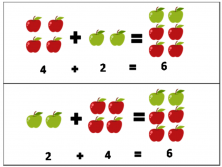-8 x 2.5
-20
7 x n = -56
-8
TRUE or FALSE
Explain your answer.
FALSE - Multiplying/dividing two negative numbers will always result in a positive answer.
 Explain how the image represents the commutative property. Use rich mathematical vocabulary.
Explain how the image represents the commutative property. Use rich mathematical vocabulary.
The number of apples swaps order but the sum is equivalent. The communitive property says that the order of the two numbers being added or multiplied won't change the sum or the product.
(1/3) divide (-7/8)
-8/21
-2
TRUE or FALSE.
Explain your reasoning.
TRUE - A negative number multiplied or divided by a positive is ALWAYS negative no matter how big or small the absolute value of the number.
How do you turn a fraction into a mixed number?
Ex
12/5
I know 5/5 is one whole. I can decompose the fraction in two 2 whole numbers (5/5 + 5/5). Then I have 2 left from 12 as my remainder. So my answer is
2 2/5
.
2 1/3 times 3/4
21/12 or 1 3/4
(-56) / (-7) = n
n = 8
A small positive number plus a large negative number will equal a negative number.
p + (-N) = -N
TRUE or FALSE
Explain your reasoning.
TRUE.
3 + (-10) = -7
I could use a number line to show I started on positive 3 and moved down (back) 10 spaces. I would end on a negative value, because the negative is bigger than the positive.
(-108)/36 = ____
Explain two different strategies to solve this problem.
1) I know a fraction bar means division, so I can use long division or partial quotients to see how many 36's split equally into -108. I know my answer will be negative because a negative divided by a positive = negative.
2) I can simplify the fraction. Since both numbers are equal, I know they are divisible by 2. I see my answer is divisible again, so I keep reducing the fraction by dividing the numerator and denominator by the same number.
(-108)/36 = (-54)/18 = (-27)/9 = -3
-52.5 divide -5
10.5
n / (-7) = 6
n = -42
TRUE / FALSE
Explain your reasoning
FALSE: Subtracting a negative is like adding. If you start with -2 and move 8 spaces in the POSITIVE direction, you will end with a positive number.
(-2) - (-8) = 6
How do you turn a decimal into a mixed number? Does this process change if the decimal is positive or negative?
To turn a decimal into a fraction, I look at the place value after the decimal. If the number ends in the 10th place, I put the fraction over 10. If the decimal number ends in the 100th place, I put the fraction over 100.
Example. 2.78 ends in the hundredth place so the fraction is 2 whole numbers and the fraction.
2 78/100
-3.5 x 2.2
-7.7
(n) - (-8) = 56
n = 48
(-N) + (P) = 0 for any value of N and P that have equal absolute values.
TRUE/ FALSE
Explain
TRUE - If N and P are equal values and one is positive and one is negative, they will always add to equal 0
(-9) + (9) = 0
How do you divide a mixed number with a decimal?
6.8 divide (1/2)
First I turn the fraction into a decimal by seeing how many times the denominator divides equally into the numerator (How many times does 2 fit into 1?). 1/2 = 0.5
Then I use place value to move the decimal out of the divisor. 0.5 --> 5
Since I moved the decimal one place value in the divisor, I must do that to the dividend. 6.8 --> 68. Next I can use long division.